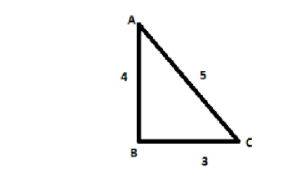
The numerical ratio of displacement to distance for a moving object is
A. Always less than 1
B. Always equal to 1
C. Always more than 1
D. Equal to or less than 1
Answer
480k+ views
Hint:Displacement is a vector quantity while distance is a scalar quantity. Displacement depends on the direction as well as the magnitude, while distance only depends on the magnitude and not on the direction. Displacement is the distance between the final point and the initial point of the moving object.
Complete step by step solution:
Distance is the length of the total path that an object has travelled from one point to another. It will take into account all the paths that were taken by the object to reach its destination. Distance is a scalar quantity. It has a magnitude but does not have a specific direction to it. The SI unit of distance is meters.
Displacement is the distance of the object obtained by joining a straight line from the final point of the object to its initial point. It is a vector quantity. It depends upon the magnitude as well as the direction that the object has taken. Its SI unit is meters as well.
For an object travelling in only one direct6ion in a straight line, the distance of that object is equal to its displacement. For an object travelling as shown in the figure, starting from A and reaching to C, then here distance would be AB+BC which is 7 meters while the displacement would be AC which is 5 meters.

Hence, displacement to distance ratio is always equal to or less than 1.
Thus option (D) is the correct answer.
Notes:Displacement is used to find the work done by an object and not distance. This is because work done is a state function just like displacement; it depends only on the initial and final state of the object.
While distance is a path function, which depends upon the path used by the object to travel a distance not just depending on its state.
Complete step by step solution:
Distance is the length of the total path that an object has travelled from one point to another. It will take into account all the paths that were taken by the object to reach its destination. Distance is a scalar quantity. It has a magnitude but does not have a specific direction to it. The SI unit of distance is meters.
Displacement is the distance of the object obtained by joining a straight line from the final point of the object to its initial point. It is a vector quantity. It depends upon the magnitude as well as the direction that the object has taken. Its SI unit is meters as well.
For an object travelling in only one direct6ion in a straight line, the distance of that object is equal to its displacement. For an object travelling as shown in the figure, starting from A and reaching to C, then here distance would be AB+BC which is 7 meters while the displacement would be AC which is 5 meters.

Hence, displacement to distance ratio is always equal to or less than 1.
Thus option (D) is the correct answer.
Notes:Displacement is used to find the work done by an object and not distance. This is because work done is a state function just like displacement; it depends only on the initial and final state of the object.
While distance is a path function, which depends upon the path used by the object to travel a distance not just depending on its state.
Recently Updated Pages
Master Class 11 Economics: Engaging Questions & Answers for Success

Master Class 11 Business Studies: Engaging Questions & Answers for Success

Master Class 11 Accountancy: Engaging Questions & Answers for Success

Master Class 11 English: Engaging Questions & Answers for Success

Master Class 11 Computer Science: Engaging Questions & Answers for Success

Master Class 11 Maths: Engaging Questions & Answers for Success

Trending doubts
Which one is a true fish A Jellyfish B Starfish C Dogfish class 11 biology CBSE

What is the difference between superposition and e class 11 physics CBSE

State and prove Bernoullis theorem class 11 physics CBSE

In which part of the body the blood is purified oxygenation class 11 biology CBSE

1 ton equals to A 100 kg B 1000 kg C 10 kg D 10000 class 11 physics CBSE

State the laws of reflection of light




